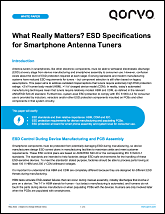Smartphone Antenna Tuner ESD Protection: What You Need to Know
September 6, 2022
Old habits can be hard to break.
Back in the days of leaded gasoline and carburetors, we were all told to change the oil in our cars every 3,000 miles. Today, with new engine technologies and tolerances, car makers recommend changing the oil every 7,000 to 10,000 miles—sometimes even more—with no loss of engine protection or performance. But there are still plenty of owners out there in new vehicles who insist on an oil change every 3,000 miles. Each visit to the garage may not cost a lot, but over time, the costs add up. Designing for smartphone antenna tuners offers a similar situation: to reduce certain outdated practices without sacrificing performance in electronic components and increasing flexibility and creativity in design.
Smartphone antenna tuners must be able to handle electrostatic discharge (ESD) during the manufacturing process. However, old habits linger about how much ESD protection is needed at each step along the way. Better standards and modern manufacturing systems are trimming the ESD requirements for tuners—but component selection is still often based on old practices and engineers are still over-designing based on old information.

The white paper “What Really Matters? ESD Specifications for Smartphone Antenna Tuners” illustrates the outdated conventions that tuners require extremely high ESD protection ratings: >2 kV human body model (HBM), >1 kV charged device model (CDM). Today’s automated manufacturing techniques mean that tuners actually need the relatively modest HBM and CDM found in the relevant ANSI/ESD S20.20 standard. System-level ESD protection to comply with the International Electrotechnical Commission (IEC) 61000-4-2 for consumer use comes from inductors, varactors and/or other ESD protection components mounted on PCBs and other components in the circuitry.
In general, the industry has been lowering ESD protection standards, particularly for HBM, as manufacturing technology becomes more automated. But the perception of the need for more stringent requirements has not changed for many designers.
This white paper clarifies:
- ESD standards and their relative importance: HBM, CDM and IEC.
- ESD protection requirements for device manufacturing and populating PCBs.
- ESD protection at board for smart phone assembly and system level for consumer use.
Why move on to new, more modest protection standards offered by modern manufacturing techniques when the established standards are clearly capable to protect products from ESD? Clearly, sticking with what works—works. That may have been a sound strategy in the past. But it is now clear that realizing the benefits of novel new technologies can be hampered by more unrealistic ESD requirements (for instance, unrealistic HBM standards today are 2000V with ANSI S20.20 setting requirement at 200V; ten times lower). As demonstrated in this paper, engineers today can now take advantage of the freedom offered by avoiding overdesigned ESD protection and promote advanced features at the same time. In fact, new disruptive tech or enabling tech ideas may not be able to meet the old, arbitrary ESD requirements and maintain the advantages of its new objectives.
Find the complete white paper here.
Have another topic that you would like Qorvo experts to cover? Email your suggestions to the Qorvo Blog team and it could be featured in an upcoming post. Please include your contact information in the body of the email.
